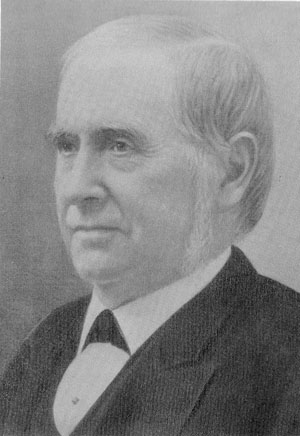 |
John Curwen
(1851-1881) Born
in 1812 at Walnut Hill, John Curwen was the oldest of four
children. He attended the Newburg Academy in Newburg, NJ
along with his brothers. He then attended Yale, graduating
in 1841 and went on to the University of Pennsylvania where
he got his medical degree in 1844. Curwen continued to study
medicine with a cousin who had a practice in Philadelphia.
He then won a appointment as the assistant physician at the
Wills Eye Hospital in Philadelphia.
In 1846 he received a
position at the Pennsylvania Hospital for the Insane in the
Mental and Nervous Department. He would remain there for
five years and eventually become
Dr. Thomas
Kirkbride's assistant. Curwen learned much from Dr.
Kirkbride, as his assistant Curwen was second in command at
the hospital. He would make rounds each morning with Dr.
Kirkbride. Curwen had been seeking a position as a
superintendent and was about to go into private practice when
he was offered the superintendent position at the new state
asylum in Harrisburg. Curwen would accept the position and
go on to be the first superintendent of the Pennsylvania
State Lunatic Hospital until 1881 when he accepted a similar
position at the state hospital in Warren, PA. Curwen was the
author of many books and papers on mental illnesses. He
served for many years as the secretary and eventually as the
president of the American Medico-Psychological Association.
He served as a building commissioner for the Dixmont,
Danville, and Warren state hospitals. He retired in 1900 and
returned to Harrisburg to live with his daughter. He
unexpectedly died on July 2, 1901, he was said to of been in
perfect health when he "just collapsed". |
| |
|
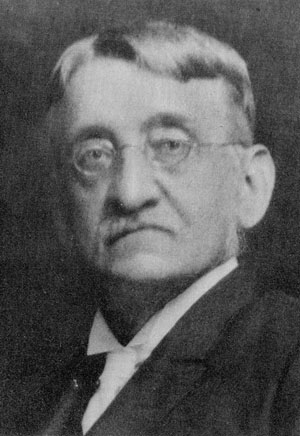 |
Jerome Z. Gerhard
(1881-1891) Born
on November 6, 1842 in Northampton County, Jerome Zwingli
Gerhard was one of five brother and three sisters. In 1859
he and his family moved to Lancaster, PA where he and his
brother could receive an education. Gerhard first attended a
country school in Durham Township. At the age of sixteen he
went to the Franklin and Marshall College, from which he
graduated in 1864. He then studied medicine with John Atlee,
the leading physician in Lancaster.
In 1865 he enlisted in the
Union Army as a private in Company K, 195th Regiment of
Pennsylvania Volunteers, he also served briefly with the
Army of the Shenandoah. When it was discovered that he had
medical experience he was quickly assigned as the steward in
the divisional hospital. He was discharged in 1866. That
fall he was accepted at the Medical Department of the
University of Pennsylvania where he would receive his
medical degree in 1868. He entered private practice in
Lancaster for two years. In 1870 he was appointed the
assistant physician at the Pennsylvania State Lunatic
Hospital under Dr. John Curwen. During his time serving with
Curwen he gained much experience, both at the hospital and
abroad. In 1877 he was sent to Europe to study asylums in
England and Germany. In March of 1881 the hospital trustees
failed to reappoint John Curwen as superintendent.
Curwen moved on to Danville and Gerhard became the second
superintendent of the hospital. He would serve the hospital
until 1891 when he decided to return to private practice. He
died on November 20, 1906 due to an illness. |
| |
|
 |
Henry L. Orth
(1891-1917) Henry
Lawrence Orth was born in Harrisburg in 1842. He attended
the Harrisburg Academy and then went on to Yale College in
1859. During the Civil War he was appointed a medical cadet
and was commissioned in the regular army in 1863. He
developed as a surgeon during the next two years in the army
and was discharged in 1865. After the war he spent one year
at the University of Pennsylvania to finish his education,
he graduated in 1867. He then returned to Harrisburg and
became a surgeon for the Northern Central Railway Company.
In 1873 he was appointed as the surgeon of the Pennsylvania
Railroad Company and in August of that year he also became a
visiting surgeon at the Pennsylvania State Lunatic Hospital,
a position that he held for eighteen years.
Orth was elected by the
trustees as the third superintendent of the hospital on
November 1, 1891. Much of his early time as superintendent
was spend rebuilding the hospital, beginning in 1893 with
the construction of a new
Administration Building. In spite of his heavy
involvement in the rebuilding, Orth did take an interest in
the clinical aspects of the hospital as well. He upgraded
the pathology works being preformed at the hospital. Orth's
annual reports tended to be short, only two or three pages.
This, in conjunction with his ability to successfully take
on the rebuilding of the hospital made him
appear to be a strong and confident leader. After
twenty-six years he retired on November 30, 1917 due to
health complication and age. He died in 1920 in Harrisburg. |
| |
|
 |
Edward M. Green
(1917-1934) Raised
in Washington, Georgia, Edward Green received his first
education in private schools in Danville, Kentucky. He
received his A.B. and M.A. degrees from Center College.
Green then attended the Medical School of Tulane University
as well as the University of Pennsylvania where he received
his medical degree. After school he went into general
practice in Danville and Versailles, Kentucky. He held
several positions in state hospitals in Kentucky, Oklahoma,
and Georgia including the position of Physician in Chief and
Clinical Director. Green also did consulting work for
several medical hospitals in Pennsylvania, including the
Lancaster County Hospital, the York Hospital, and the
Polyclinic Hospital in Harrisburg. This is how Green came of
the attention of the Board of Trustees. He took the position
as the fourth superintendent in 1917.
As a result of Green's
strong clinical background his focus was more on that of a
healing mission verses the custodial care that was
administered in pervious years. He made greater use of the
parole system and by 1919 one third of those patients that
he deemed as "curable" had been placed on parole. His time
at the hospital also saw the first outreach programs in the
way of medical clinics in Carlisle, Chambersburg,
Gettysburg, Lancaster, Lebanon, and York. Green retired in
1934. He would continue to do psychiatric consulting work
after leaving the hospital. In 1942 he would return to the
hospital as a staff psychiatrist to help Howard Petry fill
voids left by doctors that were drafted into World War II.
He died in his quarters on the hospital grounds on September
30, 1944. |
| |
|
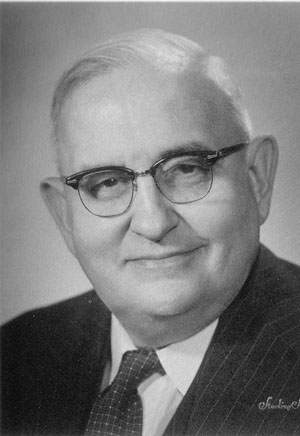 |
Howard K. Petry
(1934-1954) Howard
Petry was born on February 16, 1895 in Springfield,
Missouri. Not too long after his birth his family moved to
Wilkesbarre, Pennsylvania where Petry would attend local
schools. He graduated from Wilkes-Barre High School in 1911.
He continued his education at Wesleyan University where he
received his B.A. degree in 1915. Petry attended medical
school at the University of Pennsylvania where he got his
Doctor of Medicine degree in 1920. After completing an
internship he received a position at Warren State Hospital
in upstate Pennsylvania. In 1932 he left Warren to become
the clinical director of Torrance State Hospital, two years
later he would accept the position of superintendent at
Harrisburg.
Petry's time at the hospital
would see an expansion in the size of the campus as well as
the introduction of new technology, such as the ECT
(Electroconvulsive therapy). Petry took great pride in the
fact that Harrisburg was the first to investigate and use
new techniques and methods of treatment. His staff saw him
as an upmost professional. In 1946 Petry became the
president of the Pennsylvania State Medical Society. He
retired in December of 1954. Upon his retirement he
recommended that he be replaced by his long time assistant,
Hamblen Eaton. Petry continued to do consulting work and see
private patients from his home on Second Street in
Harrisburg until his death in April of 1962. The
Admissions Building has
been named in honor of Dr. Howard Petry. |
| |
|
 |
Hamblen Eaton
(1954-1969) Born
in Warren, Pennsylvania on March 1, 1901, Hamblen Eaton was
the eldest of three brothers and one sister. Eaton from an
early age was a tinkerer by nature, he found his love for
mechanical and electronic equipment when he would visit his
father who worked at the Valvoline Oil Plant in Warren.
Eaton graduated from Warren High School in 1918 and from
Allegheny College in 1922. He got accepted to the Western
Reserve University School of Medicine and graduated from
there in 1926. He then interned at the Allegheny General
Hospital in Pittsburg. After his internship he served
several years at the Warren State Hospital as a staff
physician, then a pathologist, and finally as clinical
director. In 1936 Eaton became the clinical director at the
Polk State School in Venango County. In 1937 Howard Petry
invited Easton to come to Harrisburg State Hospital as the
clinical director. He remained in that position until
becoming superintendent at the request of the retiring
Howard Petry in 1954. Eaton had two sons that grew up on the
hospital grounds. In 1957 he became president of the Dauphin
County Medical Society and he served several years as
Chairman of the Mental hygiene Commission of the Medical
Society of the State of Pennsylvania.
Eaton was a hands on type of
person and was likely to pop up anywhere on the hospital
campus at any time. He often repaired small pieces of
equipment in his office. When construction work on the
Admissions Building unearthed debris from the
Main Building,
Eaton took great interest in inspecting the remains. Eaton
focused on having a smooth running facility. During his
tenure as superintendent he saw many advances in treatment
methods, including new drugs used for the first time. There
was also additional expansion of the hospital with the
construction of a building that would eventually bear his
name, the Eaton Building.
Eaton retired in 1969, perhaps due to the stress of dealing
with the newly formed Pennsylvania Department of Welfare,
which was now running the state hospitals. He died in
September of 1983. |
| |
|
|
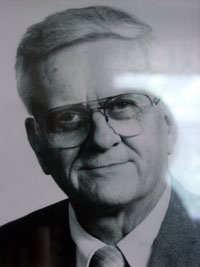 |
Stanley P. Laucks
(1969-1972)
Stanley Philip Laucks graduated from the University of
Pennsylvania's School of Medicine in 1946. After graduation
he did his residency at the Harrisburg State Hospital from
1947 to 1949. He then took a position at the Friends
Hospital in Philadelphia for two years before returning to
Harrisburg to take a position as a staff physician. In 1952
he went into private practice and left the hospital. In 1962
he returned again as the Director of Residency Training, the
following year he was promoted to the Clinical Director. He
held the position of Clinical Director until becoming
superintendent in 1969.
Laucks preferred to run the
hospital through his subordinates, during his time as
superintendent there was no open door policy as there had
been with his predecessors, even for members of the senior
medical staff. Laucks resigned in 1972 and returned to York
County where he grew up. |
| |
|
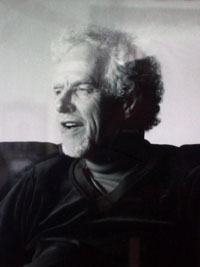 |
| John
Logan
(1974-1979) |
| |
 |
| Ford
Thompson Jr.
(1980-1988) |
|
Superintendents after 1972
After Laucks
resigned from the hospital there was a series of short term
superintendent as well as several acting superintendents. By
the 1970s the role of a state hospital superintendent was
nothing like the early days of John Curwen and Henry Orth.
Most of the decisions were now being made by the
Pennsylvania Department of Public Welfare and the
superintendent position held far less power and control
every day. The first in a series of short superintendents
was David Lasky, He had been the Director of the Research
Department for several years. Lasky held the position of
superintendent for less than six months. The next
superintendent was Frank Herzel, who was the director of the
Geriatric Unit. With in a year he resigned as superintendent
and was replaced by James Powell. Powell was a social worker
from California. He did not have a medical degree and
reportedly he was appointed to the superintendent position
with the idea of closing the hospital. He ended up resigning
less than a year later. The morale of the medical staff had
become so low by 1974 that the staff got together a petition
requesting that John Logan apply for the open superintendent
position. Logan reluctantly applied and was appointed the
new superintendent by the Department of Public Welfare in
September. Logan held the position for several years until
1979 when Ford Thompson Jr. replaced him. Thompson was from
the Department of Public Welfare, he held the position of
acting superintendent for two years before becoming the
superintendent for the next seven. When Thompson arrived, the hospital was no longer accredited as a mental health
care facility. Thompson set to work with the medical staff
to get the hospital back on track and in 1981 the hospital
was once again an accredited institution. In 1988 John
Flatley was made acting superintendent. From 1990 to 2002
Bruce Darney was superintendent and from 2002 to 2004 S.
Reeves Powers became the last superintendent. Until the hospital's
closure in 2006 the position was filled by acting
superintendents. Even the name of the
position began to change as the hospital moved into the
twenty-first century. When the hospital closed, the position
was referred to as
"Manager-In-Charge"
and
it was held by Gregory M. Smith. Today the same position at
other Pennsylvania state hospitals is
referred to as the
Chief Executive Officer
or "CEO".
|
|
![]()